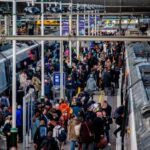Rufus Boyd, who leads the Great British Railways Transition Team (GBRTT), spoke at the recent Interchange UK event in Manchester about the two views on the challenge of integrating rail with other modes
An integrated transport system is the right aspiration. For local communities, for the prosperity of towns and cities up and down the country, as well as for our planet. It aligns with the strategic objectives that the government has given rail.
Rail has often been described as the “backbone” of that transport system. Fixed infrastructure with fixed timetables that do the heavy lifting, with which more flexible modes can “dock in” with. In a geographical sense, other modes must come to rail.
This reality can easily breed complacency, which is why all of us who work in rail must actively work towards making rail more accessible and easy to do business with.
Short-term view
I will come onto the longer-term opportunities for a railway that’s easier to work and integrate with, but first, I’d like to turn to more immediate matters because we are facing a significant financial challenge in rail, and what we don’t measure we can’t manage.
Colleagues at GBRTT have spent the past two years working to bring together a single view of industry finances – with profit and loss across track and train from the highest to the most granular levels – for the first time in a generation. The fact we’ve not had this simple business tool as an industry speaks to how much work there is to do.
Rail’s operating subsidy last year was £4.4 billion materially larger than pre-COVID (this is the Department for Transport (DfT) procured train operating companies and Network Rail – enhancements). You can also see that £2 billion revenue gap from 2019/20 to the last full financial year.
Our financial position today as an industry is simply not sustainable and it is my belief that this is true of any Government of any colour – given other public priorities. We need to get more people taking the train, more often, and we need to do that at an efficient cost.
You’ll be familiar with pre and post pandemic graphs. The dip and then rise. Rail’s revenue was decimated when the country stopped to stop the spread of Coronavirus, and when you adjust for inflation and the opening of the Elizabeth Line we’re only at 74 per cent of pre-pandemic passenger revenue.
You’ll see that this chart shows this figure split by journey purpose. Habits have changed – people are travelling – relatively – far more for leisure than they were pre-pandemic, and with changed working arrangements they’re travelling far less for business. Rail needs to adapt and across the sector, we’re trying to do just that.
In a tough financial spot, businesses have two options – you drive costs down, or you work to increase revenue. Our evidence base, which we have bolstered substantially over the past two years, suggests that there are millions of journeys to go at, through mode shift. We just need to chase the right horses.
Rail’s mode share today is low. The chart on the left draws on anonymised and aggregated mobile data (a non-traditional source), which allows us to more accurately track travel patterns. For example, the number of people travelling on different train service and the proportion of journeys taken by road versus rail on any given day – not back-solved from ticket sales data.
The rail industry can only go so far towards addressing some of these barriers respondents cited in isolation. Simplifying the complex mass of rail fares, for example. But in most cases we need partners’ support to chip away at over the longer term. Especially, as you can see, end-to-end journeys was the largest barrier cited.
Rail is a fragmented industry. The large and obvious consequences of that fragmentation is precisely why the Government set out to reform it. But we don’t yet have Great British Railways, and so coalescing the views of rail leaders – who are incentivised very differently in today’s structure – around a shared approach is painstaking but incredibly important work.
In the short term, there are five priority areas that everyone can broadly agree should be the focus of existing investment, to get the best net benefit across rail’s balance sheet.
1. Improving performance.
2. Making ticketing simpler and better value for money.
3. Optimising capacity and increasing occupancy.
4. Bringing a consistently great customer proposition.
5. Improving communications and quality of information.
These are national priority areas, and some of the key activities that sit under each of these will be done at a national level – where it makes most sense. But crucially, local leaders are developing local responses. The framework GBRTT has developed is about bringing different organisations together to use our collective clout to go for growth.
Take pricing. The second Great British Rail Sale, launched this January, GBRTT developed the business case, and worked with the Rail Delivery Group and operators to deliver a proposition that worked across their different commercial models.
It’s great news for customers, who can take advantage of the discount fares, and it’s great news for the industry who see short and long term increases in demand. Against a difficult backdrop, it’s a shining example of rail pulling together to do the right thing – encouraging more people across the country to choose to travel by train, more often.
Retailers have jumped at the opportunity and I was once again reminded – when I saw a push notification from Uber to check out the Great British Rail Sale – of the incredible work commercial organisations do to simplify end-to-end journeys involving rail for customers.
Pay-As-You-Go pilots in 90 stations across Greater Manchester and the West Midlands, announced earlier this year, and unlocked through partnership working. These pilots mean a simpler experience for customers who can tap in and out. In the West Midlands, customers will be able to travel seamlessly on local bus, tram and train services, because the pilot will integrate rail with the existing ‘Swift’ smartcard. A similar ambition exists in Manchester, to integrate rail into the Bee Network.
Long-term view
We need to tackle rail’s finances in the short term, because greater integration is predicated on that backbone having a sustainable future. To turn to the long-term picture, our research into mode shift also found that – where rail was an option – getting to-and-from a railway station was the largest barrier and led to the individual ultimately choosing another mode.
The government’s strategic objective for rail, on meeting customer needs, includes the ambition to meet multi-modal expectations and reduce end to end journey time.
Now, clearly rail is not always the answer to a specific origin and destination pair. There are things we do well, and – frankly – there are things that other modes do far better and that includes the car.
But we do know that rail is the only enabler to a broad-based solution: an unlocker of local and national growth and prosperity. We know that it has a part to play in the decarbonisation of the wider transport network. A material role to play in helping to tackle road congestion.
As long ago as the 1970s, even British Rail understood that. They even did a marketing campaign about it, showing crowded motorways criss-crossing Westminster. The rail industry is waking back up to rail’s role in this space, and to the need to focus on passengers’ end-to-end journeys – not just from station-to-station.
So, what’s needed? The answer lies in the detail of our rail reform agenda – in the work happening as we speak to improve rail’s strategic planning, partnership working with city regions, and to bring greater alignment across track and train.
Strategy is the common currency between institutions and this is how we integrate rail’s expertise with the ambitions of Mayors, local authorities, third party and private sector providers.
GBRTT is developing a long term strategic approach for the rail industry, which will help achieve national objectives, such as economic growth and net zero. Its supporting framework, underpinned by analysis, will foster joined-up decision-making across track and train, while the strategy will provide a clear future direction to industry and wider stakeholders.
The Government has published the draft Rail Reform Bill for pre-legislative scrutiny, and although we are unlikely to get the legislation needed to create Great British Railways in this Parliamentary session, the benefit of getting alignment on this is crucial.
Now is the time to align incentives to make sure that both parts of the railway enterprise – track and train – are working together to deliver for customers, which will also make rail a better industry to do business with. This isn’t impossible in the here and now – it’s just more difficult – yet we’re making progress.
The Secretary of State for Transport recently wrote to GBRTT to ask us to progress recommendations we made for simplifying rail industry processes. This includes consent processes for improving facilities at stations and depots.
Today they are unnecessarily complicated, expensive and lengthy. It shouldn’t take months to get approval for something as simple as a new EV charging point or cycle parking facility for passengers – but often, it does.
We’re now getting on with integrating and modernising three overlapping processes that exist today – Station Proposals for Change, Landlord’s consent, and Minor Modification – into a single, simplified industry approach. It may sound rather dry and ‘back-end’, but passengers, freight users and taxpayers will see a difference. A quicker, less expensive process has real potential to encourage investment in stations and unlock commercial opportunities.
Finally, we believe that rail must push decision-making down to the most local level. We need to get the railway industry actively thinking about journeys from door to door, rather than from station to station. And there’s a hunger in city regions to make that integration happen. We’re seizing that opportunity today with regional partnerships to give local leaders greater influence over the railway, including in Greater Manchester.
Once created, Great British Railways will take up that mantle and build on the foundations we’ve laid, with a de-centralised approach to decision-making

